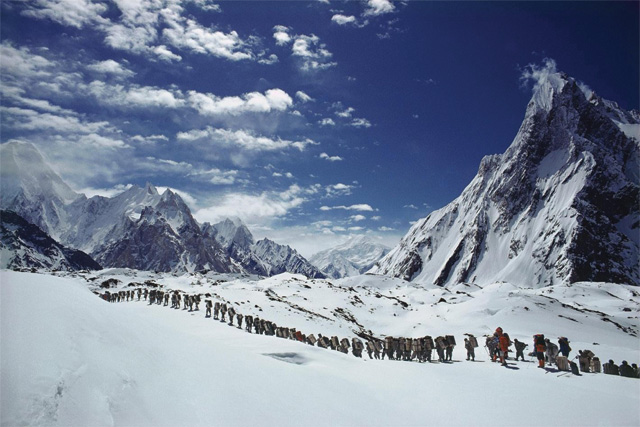There are so many mountaineering books on the market these days that if stacked high they would challenge Everest itself. Some are real gems, and while they may tell us a lot, they often show us very little, like thin soup short on memorably lyrical imagery.

I once heard a hard rock mountaineer describe a difficult climb, painting it (orally) in such graphic terms that I could almost hear the ka-chink of carbon steel pitons being pounded into solid rock. Another climber spoke in softer, more philosophical, almost reverential tones. Instead of pitons on rock he gave his audience the glimpse of a tiny blue flower growing like an orphan out of a crack in a cliff wall, catching the first warm rays of morning sun.
Both were equally engaging speakers, and each captivated his audience with fine word images. Remarkably, they had climbed the mountain together − same-same, but different.
In mountaineering books, too, writers may also reveal personal perspectives and images in astonishingly dissimilar ways. Peter Zuckerman and Amanda Padoan’s book, ‘Buried in the Sky: The Extraordinary Story of the Sherpa Climbers on K2’s Deadliest Day’ (2012) is a case in point. It is about a disastrous climb on the world’s second highest peak, considered more savage, more dangerous and downright ‘meaner’ than Mount Everest with which it is often compared.
Other book titles reveal something of its treacherous reputation. For example, ‘K2, the Savage Mountain’ (Houston and Bates, 1954), ‘K2: Life and Death on the World’s Most Dangerous Mountain’ (Viesturs and Roberts, 2009), and ‘No Way Down: Life and Death on K2’ (Bowley, 2010), to name a few.
While they are good reads, ‘Buried in the Sky’ stands above them as extraordinarily engaging. Here are some examples of the creative word smithing in it.
At base camp, Chhiring Sherpa paused in prayer to the mountain goddess for safe passage. When he opened his eyes and scanned the horizon − “Hidden behind storms for weeks, K2’s summit materialized and seemed to swallow the sky.” That unforgettable swallow is an example of anthropomorphism, humanizing the inanimate.
To Pasang Sherpa the summit was a “most perfect place” where, “For an instant, exhaustion evaporated. The panorama dizzied him. The sun was slipping like a brass coin into a pocket behind K2...” Did you see a glint on the coin?
And Zuckerman and Padoan don’t simply tell us that climbing in the ‘Death Zone’ (above 26,000 ft, or 8000 m) is difficult or dangerous or death-defying. Rather it’s like trying “to run up a staircase while breathing through a straw.”
Early in the book, they describe the long walk to base camp up the rocky, glaciated Korakoram valleys. How boring it might be. Instead, their words skillfully weave important detail into the approach march with remarkable imagery, using visually striking description peppered with high action verbs that stir the emotions and keep our attention riveted to the page 46 and 48.
The hundreds of porters, trudging one behind the other, formed human trains stretching for miles...
Thrashing through an undergrowth of scrub and wild rose, the porters brushed against spines as long as sewing needles. When temperatures scorched to 115 degrees, the men doused their heads in the side creeks... After two days, the poplars vanished, then the grass. The Baltoro Glacier, a thirty-five-mile tongue of ancient ice, rippled ahead. To the north stood the earth’s tallest rock walls, the Trango Towers. Beneath the ice, a rush of subglacial melt could be heard, feeding the Braldu River. Sometimes the sun punched through the clouds, and from a single point in the sky, amber beams radiated downward in columns.
Within a week, the climbers had reached Concordia, where the Baltoro Glacier collides with the smaller Godwin-Austen Glacier. As the buckling ice cracked like rifle shots, K2 stood before them... Framed by lesser peaks, the pyramid seemed to prop up the weight of the sky.
You can read the full book review in page 46 and 48.











